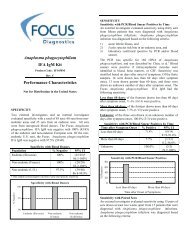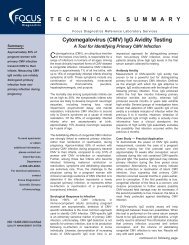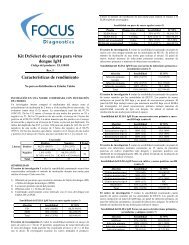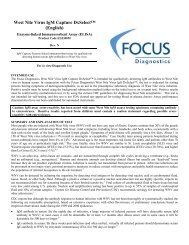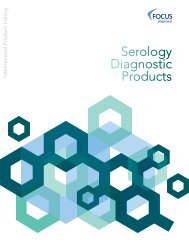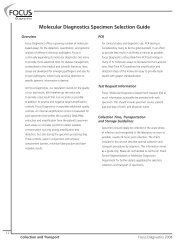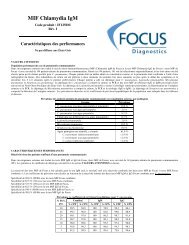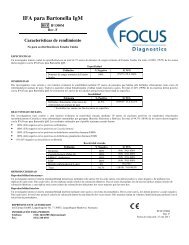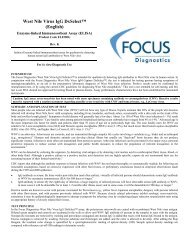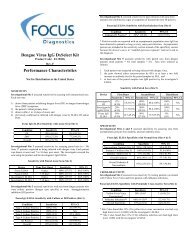Trousse DxSelect Virus de la dengue IgG Caractéristiques des ...
Trousse DxSelect Virus de la dengue IgG Caractéristiques des ...
Trousse DxSelect Virus de la dengue IgG Caractéristiques des ...
- No tags were found...
You also want an ePaper? Increase the reach of your titles
YUMPU automatically turns print PDFs into web optimized ePapers that Google loves.
Cas positifs par culture, 100 % (1/1) S/Otype 2Cas positifs par culture, 100 % (5/5) 47,8-100 %type 3Cas positifs par culture, 100 % (1/1) S/Otype 4Cas positif par HI 96 % (23/24) 78,9-99,9 %Globalement 95 % (37/39) 82,7-99,4 %<strong>Trousse</strong> <strong>DxSelect</strong> <strong>Virus</strong> <strong>de</strong> <strong>la</strong> <strong>de</strong>ngue <strong>IgG</strong>Co<strong>de</strong> produit : EL1500GRév. FCaractéristiques <strong>de</strong>s performancesNe pas diffuser aux États-UnisSENSIBILITÉLe site d’investigation 1 a évalué <strong>la</strong> sensibilité en testant <strong>de</strong>s échantillons <strong>de</strong>sérum bien définis. Chaque échantillon était :1) prélevé chez <strong>de</strong>s patients présentant <strong>de</strong>s symptômes <strong>de</strong> <strong>la</strong> <strong>de</strong>ngue (DF) ou<strong>de</strong> <strong>la</strong> <strong>de</strong>ngue hémorragique (DHF),2) le prélèvement initial du patient,3) prélevé dans une p<strong>la</strong>ge <strong>de</strong> 1 à 16 jours <strong>de</strong>puis le début <strong>de</strong>s symptômes, et4) confirmé préa<strong>la</strong>blement comme infecté par le virus <strong>de</strong> <strong>la</strong> <strong>de</strong>ngue à l’ai<strong>de</strong><strong>de</strong> tests ELISA, HI et/ou PCR.Sensibilité du test ELISA <strong>IgG</strong> <strong>de</strong> Focus avec échantillons <strong>de</strong> sérum enphase aiguë (Site 1)Condition Sensibilité IC à 95 %Dengue 98 % (49/50) 89,4-99,9 %Dengue hémorragique 93 % (27/29) 77,2-99,2 %Globalement 96 % (76/79) 89,3-99,2 %Le site d’investigation 2 a évalué <strong>la</strong> sensibilité en testant <strong>de</strong>s échantillonsappariés <strong>de</strong> sérum (n = 34) provenant <strong>de</strong> 17 patients chez lesquels uneinfection par le virus <strong>de</strong> <strong>la</strong> <strong>de</strong>ngue était soupçonnée. Chaque patient a subi unprélèvement au début <strong>de</strong>s symptômes et 7 à 10 jours plus tard. L’investigateura testé les échantillons à l’ai<strong>de</strong> du produit et d’un test ELISA <strong>IgG</strong> <strong>de</strong>l’investigateur.Sensibilité avec <strong>de</strong>s échantillons appariés <strong>de</strong> sérum en phase aiguë (Site 2)<strong>Trousse</strong> Durée <strong>de</strong>puis le Sensibilité IC à 95 %début <strong>de</strong>ssymptômesELISA <strong>de</strong> Focus 0 jours 100 % (17/17) 80,5-100 %ELISA <strong>de</strong> Focus 7-10 jours 100 % (17/17) 80,5-100 %ELISA <strong>de</strong> l'investigateur 0 jours 100 % (17/17) 80,5-100 %ELISA <strong>de</strong> l'investigateur 7-10 jours 100 % (17/17) 80,5-100 %Le site d’investigation 3 a évalué <strong>la</strong> sensibilité en testant <strong>de</strong>s échantillons <strong>de</strong>sérum provenant <strong>de</strong> patients <strong>de</strong> <strong>la</strong> <strong>de</strong>ngue positifs par culture (spécifique dutype <strong>de</strong> virus) ou positifs par test d’inhibition <strong>de</strong> l’hémagglutination (HI).Sensibilité du test ELISA <strong>IgG</strong> <strong>de</strong> Focus avec échantillons <strong>de</strong> sérumpositifs par culture ou HI (Site 3)Condition Sensibilité IC à 95 %Cas positifs par culture, 88 % (7/8) 47,3-99,7 %type 1Le site d’investigation 4 a évalué <strong>la</strong> sensibilité envers les infectionsantérieures en testant <strong>de</strong>s échantillons <strong>de</strong> sérum provenant <strong>de</strong> patients neprésentant aucun symptôme <strong>de</strong> <strong>la</strong> <strong>de</strong>ngue mais étant positifs par testd’hémagglutination.Sensibilité du test ELISA <strong>IgG</strong> <strong>de</strong> Focus avec échantillons <strong>de</strong> sérum <strong>de</strong>patients ayant eu une infection antérieure (Site 4)Condition Sensibilité IC à 95 %Endémique, positif par 39 %* (13/33) 22,9-57,9 %HI** Des résultats positifs sont attendus pour cette popu<strong>la</strong>tion asymptomatique,car l’<strong>IgG</strong> a été détecté chez <strong>de</strong>s patients jusqu’à soixante ans après l’infection.Les individus asymptomatiques sont inclus dans <strong>la</strong> section portant sur <strong>la</strong>sensibilité et non sur <strong>la</strong> spécificité, parce que le but <strong>de</strong> ce test est « d’établirune exposition antérieure » plutôt que d'ai<strong>de</strong>r au diagnostic.Le site d’investigation 5 a évalué <strong>la</strong> sensibilité en testant <strong>de</strong>s échantillons <strong>de</strong>sérum appariés provenant <strong>de</strong> patients <strong>de</strong> <strong>la</strong> <strong>de</strong>ngue (30 patients, 61échantillons au total). Les échantillons <strong>de</strong> sérum ont été sélectionnés enfonction <strong>de</strong>s critères suivants :1. Chaque patient était soupçonné d’être infecté par le virus <strong>de</strong> <strong>la</strong> <strong>de</strong>ngue.2. Les paires d’échantillons présentaient soit une séroconversion par IHA,soit une augmentation d’un facteur <strong>de</strong>ux au minimum <strong>de</strong>s titresd’anticorps pour les échantillons appariés par IHA, et3. Au moins un <strong>de</strong>s échantillons appariés était positif pour l'IgM selon letest ELISA <strong>de</strong> l'investigateur.Sensibilité avec <strong>de</strong>s échantillons appariés <strong>de</strong> sérum (Site 5)<strong>Trousse</strong> 1 er prélèvement 2 ème prélèvement 3 ème prélèvementSensibilité IC à 95 % Sensibilité IC à 95 % Sensibilité IC à 95 %HI <strong>de</strong>l'investigateurELISA <strong>de</strong>l'investigateurELISA <strong>IgG</strong><strong>de</strong> Focus13 %(4/30)20 %(6/30)30 %(9/30)3,8-30,7 %100 %(30/30)7,7-38,6 %100 %(30/30)14,7-49,4 % 90 %(27/30)88,4-100 %88,4-100 %73,5-97,9 %100 %(1/1)100 %(1/1)0 %(0/1)SPÉCIFICITÉLes sites d’investigation 4 et 5 ont évalué <strong>la</strong> spécificité en testant <strong>de</strong>séchantillons <strong>de</strong> sérum provenant d’individus asymptomatiques dans <strong>de</strong>srégions endémiques ou non.Spécificité du test ELISA <strong>IgG</strong> <strong>de</strong> Focus avec échantillons <strong>de</strong> sérumnormaux (Sites 4 et 5)Condition Spécificité IC à 95 %Normal, non endémique (Site 4) 99 % (158/160) 95,6-99,9 %Enfants, endémique (Site 5) 100 % (43/43) 91,8-100 %Adultes, endémique (Site 5) 77 % (52/68) 64,6-85,9 %Globalement, endémique 86 % (95/111) 77,7-91,5 %Globalement, endémique et nonendémique93 % (253/271) 89,7-96,0 %RÉACTIONS CROISÉESLe site d’investigation 2 a évalué <strong>la</strong> réactivité croisée en testant <strong>de</strong>s patientsvaccinés contre le virus <strong>de</strong> <strong>la</strong> fièvre jaune et <strong>de</strong>s patients infectés par le virusinfluenza.S/OS/OS/O
FOCUS DiagnosticsDengue <strong>Virus</strong> <strong>IgG</strong> <strong>DxSelect</strong>Page 2Spécificité du test ELISA <strong>IgG</strong> <strong>de</strong> Focus avec échantillons <strong>de</strong> sérum àréactions croisées potentielles (Site 2)Condition Spécificité IC à 95 %Immunisation contre le 50 % (3/6)* 11,8-88,2 %virus <strong>de</strong> <strong>la</strong> fièvrejaune*Infections par 60 % (9/15)** 32,3-83,7 %influenza**Spécificité globale 57 % (12/21) 34,0-78,2 %* Le site 2 a également observé que 33 % (2/6) <strong>de</strong>s sérums aprèsimmunisation contre le virus <strong>de</strong> <strong>la</strong> fièvre jaune comportaient <strong>de</strong>s titres trèsélevés (plus <strong>de</strong> 1/10 000) avec le test ELISA <strong>de</strong> l'investigateur.** Le site 2 a également observé que 31 % (5/16) <strong>de</strong>s cas après infection parinfluenza comportaient <strong>de</strong>s titres élevés (plus <strong>de</strong> 1/600) avec le test ELISA<strong>de</strong> l'investigateur.Le site d’investigation 8 a évalué <strong>la</strong> réactivité croisée en testant <strong>de</strong>séchantillons <strong>de</strong> sérum <strong>de</strong> patients infectés par d’autres f<strong>la</strong>vivirus, ainsi qued’autres types <strong>de</strong> virus. Les <strong>de</strong>ux panels d’échantillons ont été testés à l’ai<strong>de</strong><strong>de</strong> <strong>la</strong> trousse <strong>de</strong> Focus, du test HI <strong>de</strong> l’investigateur et d’un test ELISA IgM <strong>de</strong>l’investigateur. Le panel d'échantillons du f<strong>la</strong>vivirus comportait 33échantillons <strong>de</strong> sérum <strong>de</strong> patients infectés avec d'autres f<strong>la</strong>vivirus : virus <strong>de</strong> <strong>la</strong>fièvre jaune, virus du Nil occi<strong>de</strong>ntal, virus chikungunya, virus <strong>de</strong> l'encéphalitejaponaise, virus <strong>de</strong> <strong>la</strong> fièvre à phlébotome, virus <strong>de</strong> Langat, bunyavirus etvirus Wesselsbron.Réactivité croisée chez les individus infectés par les f<strong>la</strong>vivirus (Site 8)<strong>Trousse</strong>Test HI Dengue type 2<strong>de</strong> l’investigateurTest ELISA IgMDengue <strong>de</strong>l’investigateurTest ELISA Dengue<strong>IgG</strong> <strong>de</strong> Focus<strong>Trousse</strong>HI <strong>de</strong>l'investigateurELISA <strong>IgG</strong> <strong>de</strong>FocusRéactionsIC à 95 %croisées39 % (13/33) 22,9-57,9 %12 % (4/32) 3,5-29,0 %61 % (20/33) 42,1-77,1 %Réactivité croisée du test ELISA Dengue <strong>IgG</strong> <strong>de</strong> Focuschez les individus infectés par d’autres virus (Site 8)Réactions croiséesEBV ACV CMV VHS VZV Parvovirus Globalement0 % 0 % 0 % 33 % 20 % 10 %(0/4) (0/4) (0/5) (1/3) (1/5) (2/21)25 % 0 % 0 % 33 % 40 % 19 %(1/4) (0/4) (0/5) (1/3) (2/5) (4/21)STABILITÉLes constituants ont été soumis à un vieillissement accéléré équivalent à 1 anà une température comprise entre 2 et 8 ºC, en les incubant à 37 °C. Lesconstituants soumis au vieillissement accéléré ont ensuite été testés selon <strong>la</strong>notice <strong>de</strong> l'embal<strong>la</strong>ge, en parallèle avec <strong>de</strong>s constituants non soumis à cevieillissement. Les constituants sont considérés stables s’ils remplissent lescritères <strong>de</strong> CQ précisés dans <strong>la</strong> notice <strong>de</strong> l'embal<strong>la</strong>ge. La trousse a réussichaque critère du CQ.REPRODUCTIBILITÉ INTRA-ESSAILe site d’investigation 4 a évalué les variations intra-essai. Deux ban<strong>de</strong>s <strong>de</strong> 8puits ont été retirées <strong>de</strong> six p<strong>la</strong>ques différentes, et les ban<strong>de</strong>s ont étéassemblées pour former une nouvelle p<strong>la</strong>que (pour un total <strong>de</strong> 12 ban<strong>de</strong>s ou96 puits). La nouvelle p<strong>la</strong>que a été utilisée pour effectuer un test selon lesinstructions <strong>de</strong> <strong>la</strong> notice, en utilisant comme échantillon le calibrateur seuil.La trousse a présenté les variations intra-essai ci-<strong>de</strong>ssous :Reproductibilité intra-essai du test ELISA <strong>IgG</strong> <strong>de</strong> FocusPuitsO.D.MoyenneCoefficient <strong>de</strong>variationBan<strong>de</strong> P<strong>la</strong>que1 & 2 1 0,143 3,2 %3 & 4 2 0,142 5,0 %5 & 6 3 0,139 4,6 %7 & 8 4 0,134 5,9 %9 &10 5 0,136 4,8 %11 & 12 6 0,143 5,8 %Total <strong>de</strong>s 12 ban<strong>de</strong>s, 2 ban<strong>de</strong>spar p<strong>la</strong>que (n = 96 puits)REPRODUCTIBILITÉ INTER-ESSAI0,139 5,4 %Le site d’investigation 4 a évalué les variations inter-essai. Les contrôles et<strong>de</strong>ux types d'échantillons (un à <strong>la</strong> limite <strong>de</strong> détection et un positif) ont ététestés une fois par semaine pendant six semaines. Chaque test a été effectuéselon les instructions <strong>de</strong> <strong>la</strong> notice du produit. Les paramètres suivants ont étécalculés : moyenne, écart-type (É.T.), coefficient <strong>de</strong> variation (C.V.) et% concordance.Reproductibilité inter-essai du test ELISA <strong>IgG</strong> <strong>de</strong> FocusÉlément n Moye É.T. C.V. % concordancenneO.D. Calibrateur seuil 6 0,342 0,055 16,1 % S/OIndice du contrôle non 6 0,023 0,011 49,4 % 100 % (6/6)détectableIndice du contrôle détectable 6 2,125 0,105 5,0 % 100 % (6/6)Indice du contrôle positif haut 6 4,990 0,396 7,9 % 100 % (6/6)(n’est plus disponible)Indice du sérum à <strong>la</strong> limite <strong>de</strong> 6 0,965 0,148 15,4 % 67 % (4/6)détectionIndice du sérum positif 6 4,818 0,515 10,7 % 100 % (6/6)REPRODUCTIBILITÉ INTER-LOTLe site d’investigation 7 a évalué les variations inter-lot. Les contrôles etéchantillons <strong>de</strong> sérum (cinq positifs et trois négatifs) ont été testés avec <strong>de</strong>uxlots <strong>de</strong> trousse différents. La trousse a présenté <strong>la</strong> reproductibilité ci-<strong>de</strong>ssous.No.IndiceInterprétationéchantillon Lot 1 Lot 2 % concordanceQC 1 0,412 0,166 100 %QC 3 0,899 0,482 100 %QC 4 1,294 1,596 100 %QC 6 2,540 2,750 100 %QC 7 3,726 4,174 100 %QC 8 7,136 6,449 100 %QC 9 13,521 10,504 100 %QC 10 0,062 0,114 100 %Cypress, Californie 90630 États-Uniswww.focusdx.comPC.EL1500GRév. FDate <strong>de</strong> rédaction : 11 août 2008



